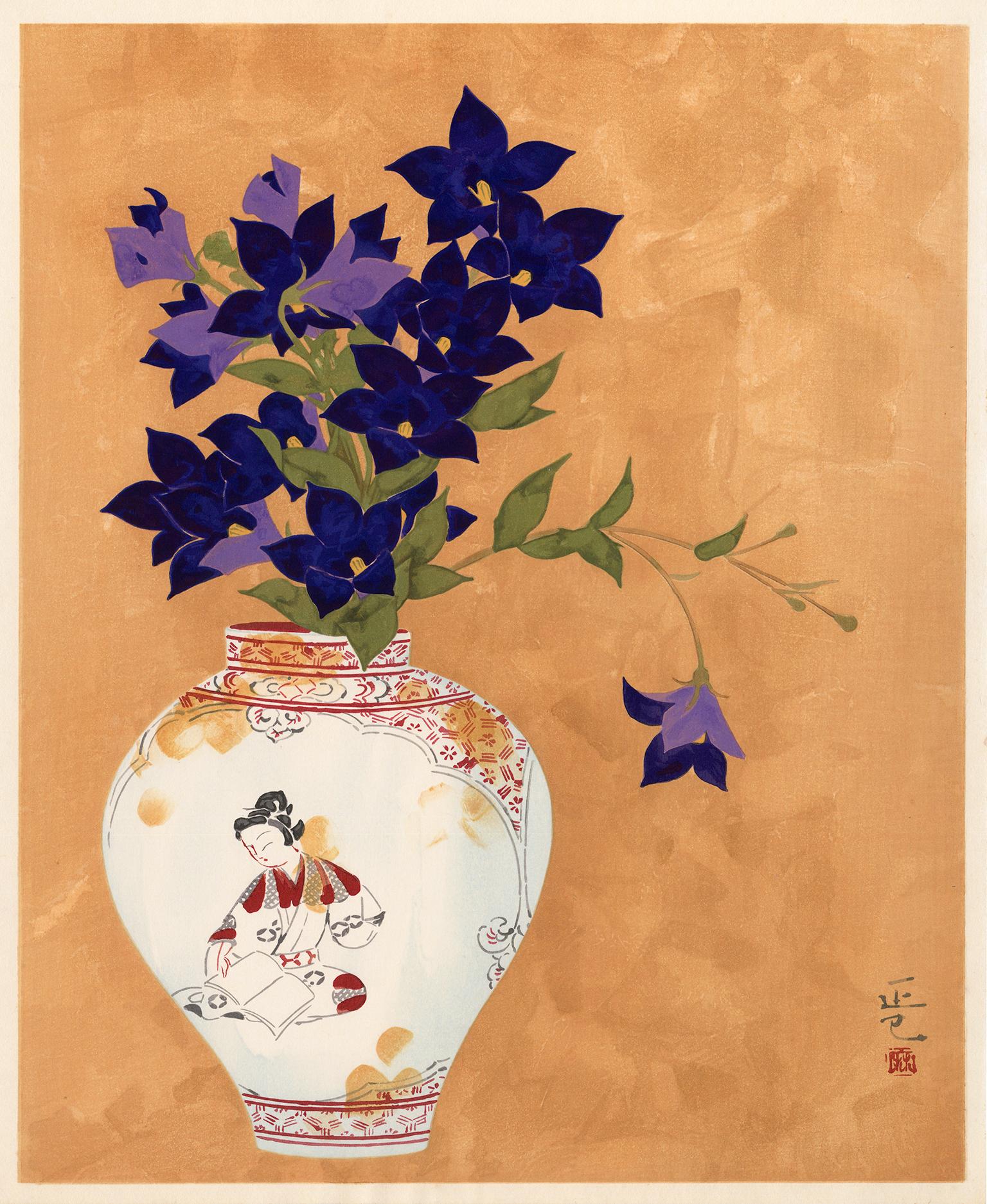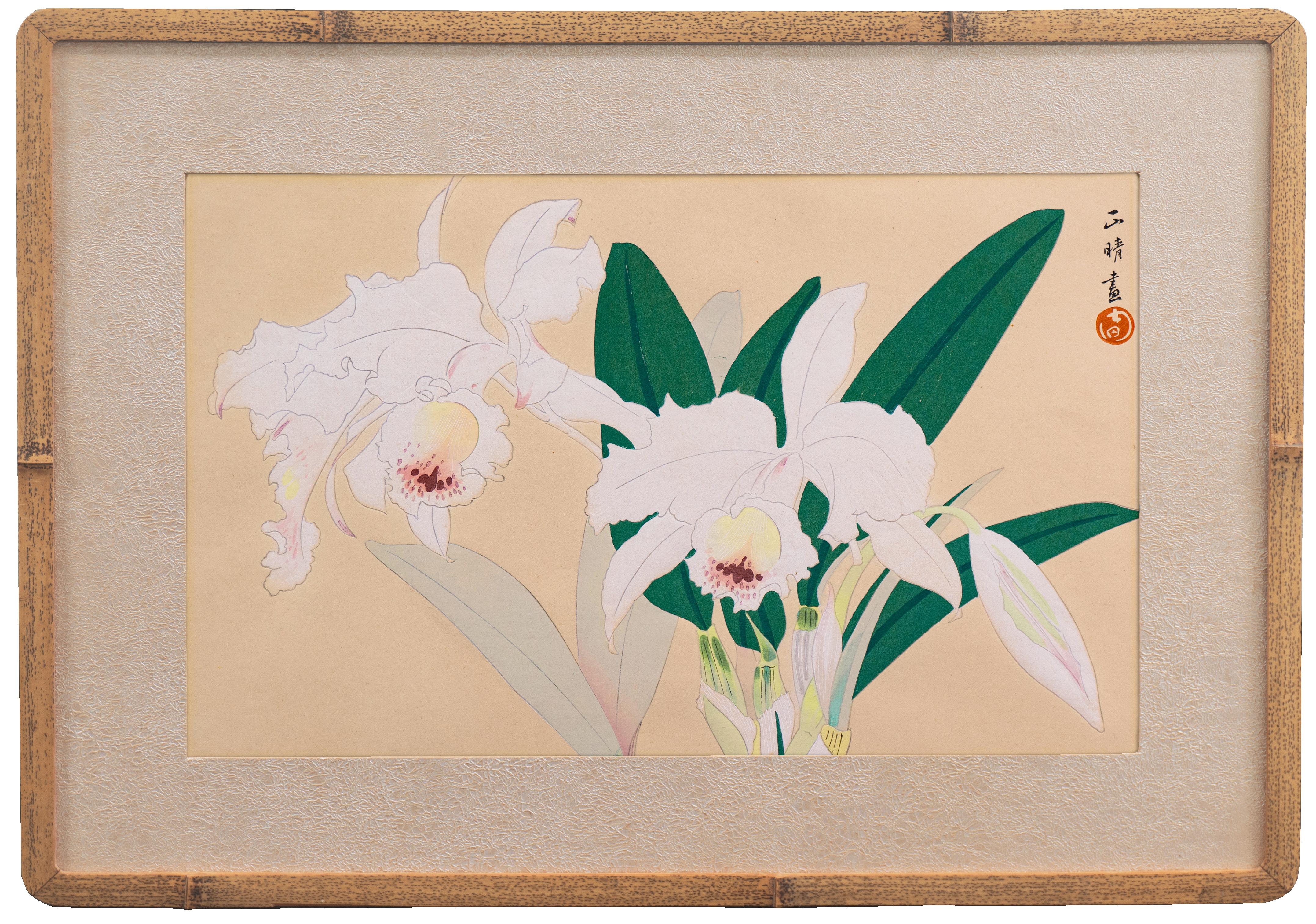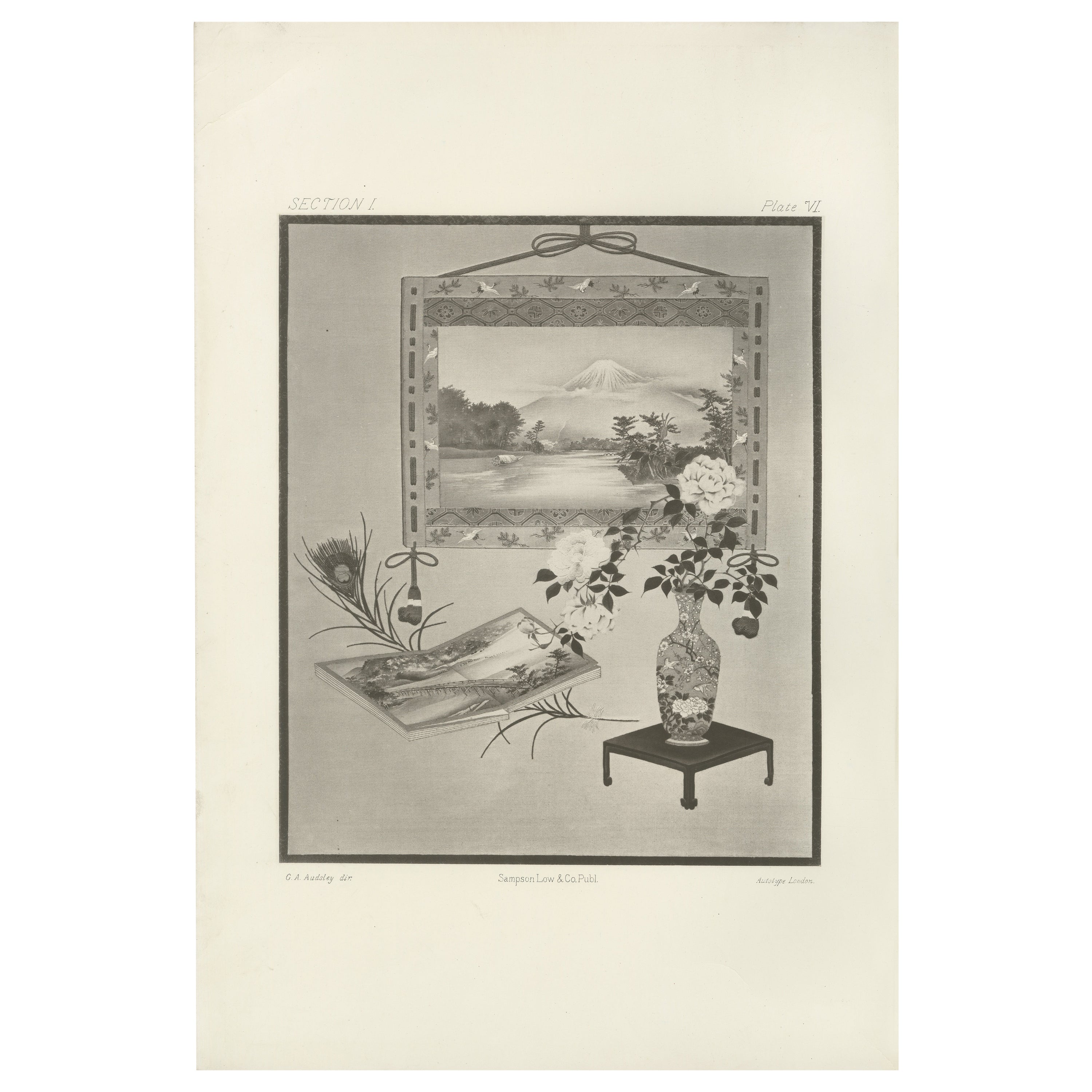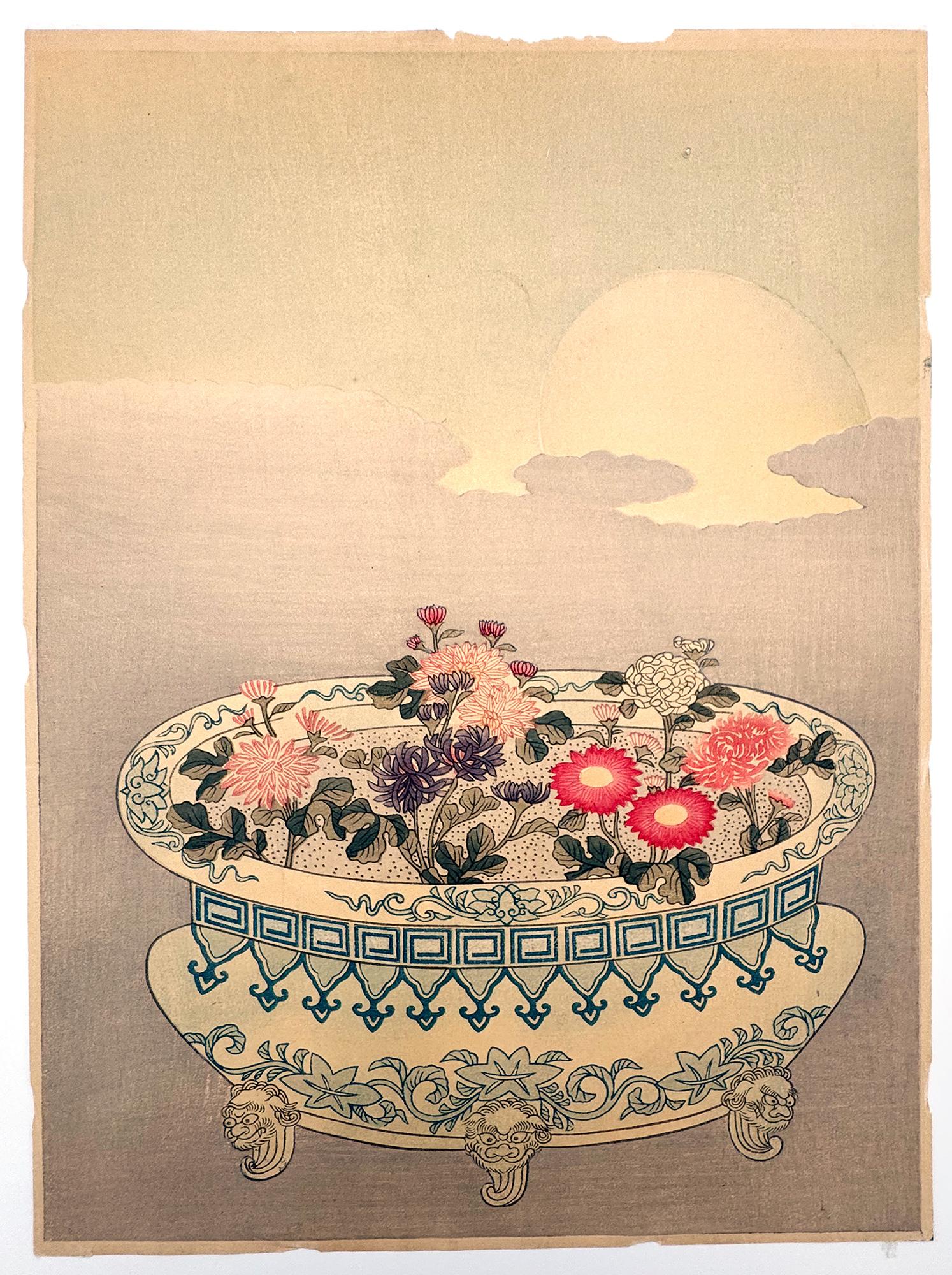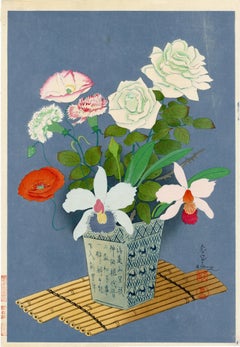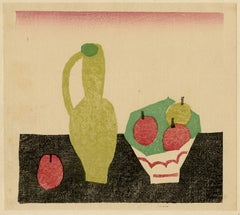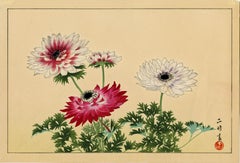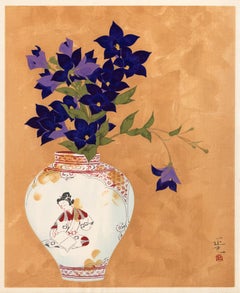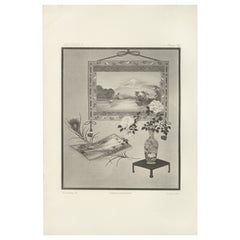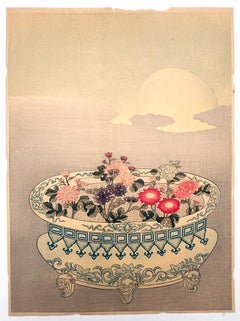Items Similar to Flower Vase, Red Camellia, white plum, white daffodils and orchids
Want more images or videos?
Request additional images or videos from the seller
1 of 11
Bakufu OnoFlower Vase, Red Camellia, white plum, white daffodils and orchidsc. 1950
c. 1950
$495
£375.06
€430.35
CA$696.54
A$765.69
CHF 402.41
MX$9,298.32
NOK 5,020.01
SEK 4,756.11
DKK 3,211.79
About the Item
Flower Vase, Red Camellia, white plum, white daffodils and orchids
Color woodcut, c. 1950
Signed "B. Ohno" (see photo)
Seal: Bakufu (see photo)
Series: Flowers of the Four Seasons
Carver: Matsuda
Printer: Ohno
Publisher: Kyoto Hanga
Condition: Excellent
Image size: 16 1/2 x 11 1/5 inches
Bakufu, Ohno
Ohno Bakufu (大野麦風, 1888-1976) was born in Tokyo and worked primarily as a painter. He is best known for his work in the sosaku-hanga, or “creative prints,” movement in the early 20th century even though he published in the shin-hanga method as well. Bakufu studied under Ishii Hakutei, a leading figure in the movement, and later worked closely with Munakata Shiko.
Bakufu’s prints often featured scenes from everyday life, including landscapes, portraits, and still lifes. He was known for his use of bold, simplified forms and vivid colors, which he achieved through a combination of traditional woodblock printing techniques and his own innovations. Bakufu was particularly interested in the expressive potential of woodblock printing, and his work often incorporated elements of abstraction and distortion.
Bakufu was part of a group of artists who sought to challenge the dominant ukiyo-e tradition and create a new form of Japanese art that reflected the modern era. The sosaku-hanga movement emphasized the artist’s individual creative process and rejected the idea of prints as reproductions of existing works. Bakufu’s work embodied this ethos, as he often carved his own blocks and printed his own work, rather than relying on a workshop system.
Despite his contributions to the sosaku-hanga movement, Bakufu’s work was largely overlooked during his lifetime. It wasn’t until the 1950s and 60s, when interest in the movement was revived, that his prints gained recognition.
In addition to his work as an artist, Bakufu was also a teacher and mentor to a generation of younger artists. He taught at the Kyoto Municipal School of Arts and Crafts, where he influenced a number of students who went on to become prominent artists in their own right.
Sources:
“Ohno Bakufu.” The Lavenberg Collection of Japanese Prints.
Kato, Junzo. The Early Creative Print Movement in Japan. Kodansha International Ltd, 1979.
“Sosaku-hanga: Creative Prints.” The Japan Times, 28 July 2016.
Coyrtesy Moonlit Sea
About the Seller
5.0
Recognized Seller
These prestigious sellers are industry leaders and represent the highest echelon for item quality and design.
Platinum Seller
Premium sellers with a 4.7+ rating and 24-hour response times
Established in 1978
1stDibs seller since 2013
813 sales on 1stDibs
Typical response time: <1 hour
Associations
International Fine Print Dealers Association
- ShippingRetrieving quote...Shipping from: Akron, OH
- Return Policy
Authenticity Guarantee
In the unlikely event there’s an issue with an item’s authenticity, contact us within 1 year for a full refund. DetailsMoney-Back Guarantee
If your item is not as described, is damaged in transit, or does not arrive, contact us within 7 days for a full refund. Details24-Hour Cancellation
You have a 24-hour grace period in which to reconsider your purchase, with no questions asked.Vetted Professional Sellers
Our world-class sellers must adhere to strict standards for service and quality, maintaining the integrity of our listings.Price-Match Guarantee
If you find that a seller listed the same item for a lower price elsewhere, we’ll match it.Trusted Global Delivery
Our best-in-class carrier network provides specialized shipping options worldwide, including custom delivery.More From This Seller
View AllFlower in Vase (Summer)
Located in Fairlawn, OH
Flower in Vase (Summer)
Color woodblock, c. 1950
Signed "B. Ohno" lower right (see photo)
Sealed lower right (see photo)
Series: Flowers of the Four Se...
Category
1950s Other Art Style Still-life Prints
Materials
Woodcut
Flower and Pot
Located in Fairlawn, OH
Flower and Pot
Color mezzotint, 1983
Signed, numbered, and dated in pencil
John Szoke Graphics blindstamp, lower right
Edition: 150 (100/150)
Image si...
Category
1980s Contemporary Still-life Prints
Materials
Mezzotint
Seibutsu (Still Life) A Vase and Apples
Located in Fairlawn, OH
Seibutsu (Still Life)
A Vase and Apples
Color woodcut, 1925
Signed on the mount (support sheet)
From: Dojin zasshi, Hanga Magazine, Volume 8, No. 8
Condition: Excellent
Image/Sheet ...
Category
1920s Showa Still-life Prints
Materials
Woodcut
Chrysanthemums
Located in Fairlawn, OH
Chrysanthemums
Color woodcut, c. 1950's
Signed lower right (see photo)
Publisher: Uchida (see photo of red seal)
Note: Chrysanthemums, a symbol of the sun, the Japanese consider the ...
Category
1950s Modern Still-life Prints
Materials
Woodcut
Plum Branches and Flowers
By Joseph O'Sickey
Located in Fairlawn, OH
Plum Branches and Flowers
watercolor on wove paper, 1985
Signed and dated in pencil lower right corner
From the artist's 1985 sketchbook
Inspired by O'Sickey's love of Japanese and Chinese art and calligraphy.
Provenance: Estate of the artist
Condition: Excellent
Image/Sheet size: 13 5/8 x 17 inches
Joseph B. O’Sickey, Painter
1974 CLEVELAND ARTS PRIZE FOR VISUAL ARTS
The title conferred on him by Plain Dealer art critic Steve Litt in a 1994 article, “the dean of painting in northeast Ohio,” must have pleased Joseph O'Sickey. It was more than 30 years since he had burst onto the local (and national) art scene. O’Sickey was already in his 40s in that spring of 1962 when he had his first one-man show at the Akron Art Museum and was signed by New York’s prestigious Seligmann Galleries, founded in 1888. In the decade and a half that followed, he would have seven one-man shows at Seligmann, which had showed the work of such trailblazing figures as Seurat, Vuilliard, Bonnard, Leger and Picasso, and appear in all of the group shows.
O’Sickey took the Best Painting award in the 1962 May Show at the Cleveland Museum of Art (CMA). He and would capture the same honor in back-to-back May Shows in 1964 and ’65, and again in 1967. The remarkable thing, noted the Plain Dealer’s Helen Borsick, was that he accomplished this sweep in a variety of painterly styles, even using that most hackneyed of subjects, flowers. “The subject doesn’t matter,” he told her, “what the artist brings to it is the important thing.” O’Sickey’s garden and landscape paintings were big and bold, eschewing delicate detail in favor of vitality and impact. The great art collector and CMA benefactor Katherine C. White, standing before one of O’Sickey’s vivid garden paintings, compared the sensation to “being pelted with flowers.”
Though he might represent an entire blossom with one or two smudged brush strokes or a stem with a simple sweep of green, O’Sickey rejected the moniker of Impressionist—or Pointillist or Abstract painter or Expressionist. “My work,” he said, “is a direct response to the subject. I believe in fervor and poetic metaphor. I try to make each color and shape visible and identifiable within the context of surrounding colors and shapes. A yellow must hold its unique quality from any another yellow or surrounding color, and yet read as a lemon or an object, by inference. It does not require shading or modeling—the poetic evocation is part of the whole.”
“The subject,” O’Sickey used to tell his students at Kent State University, where he taught painting from 1964 to 1989, “has to be seen as a whole and the painting has to be structured to be seen as a whole.” He liked to think of it as “a process of controlled rapture.”
When, in the 1960s, fond childhood memories drew him to the zoo, he found himself responding to the caged animals in their lonely dignity (or indignity) with sharp-edged, almost silhouette-like forms that evoked Matisse’s paintings and cut-paper assemblages. One observer was left with the impression that the artist had “looked at these animals, past daylight and into dusk when they lose their details in shadow and become pure shapes, with eyes that are seeing the viewer rather than the other way around. This is a world of shape and essence,” wrote Helen Borsick. “All is simplification.”
O’Sickey attributed his ability to capture his subjects with just a few strokes—in an almost iconographic way—to a rigorous exercise he had imposed upon himself over a period of several months. Limiting his tools to a large No. 6 bristle brush and black ink, he set himself the task of drawing his pet parakeet and the other small objects in its cage (cuttlebone, feeding dish, tinkling bell) hundreds of times. The exercise gave him “invaluable insights into painting. . . . Because of the crudity of the medium, every part of these drawings had to be an invention and every mark had to have its room and clarity.” Then he began adding one color at a time—“still with the same brush and striving for the same clarity”—and headed off to the zoo where “the world opened up to me. I learned how little it took to express the subject.”
Born in Detroit at the close of the First World War, O’Sickey grew up in St. Stanislaus parish near East 65th and Fleet on Cleveland’s southeast side. (The apostrophe was inserted into the family’s proud Polish name by a clerk at Ellis Island.) An early interest in drawing and painting may have been kindled by the presence on the walls of Charles Dickens Elementary School, one of only three grade schools in the district with a special focus on the arts, of masterful watercolors by such Cleveland masters as Paul Travis, Frank N. Wilcox and Bill Coombes.
As a youngster O’Sickey took drawing classes at the Cleveland Museum of Art, and he and his brother spent hours copying famous paintings; while a student at East Tech High School in the mid-’30s, he attended free evening classes in life drawing with Travis and Ralph Stoll at the John Huntington Art and Polytechnic Institute, and Saturday classes at the Cleveland School (later the Cleveland Institute) of Art, where he earned his degree in 1940 under the tutelage of Travis, Stoll and such other legendary figures as Henry Keller, Carl Gaertner, William Eastman, Kenneth Bates...
Category
1980s Contemporary Still-life Drawings and Watercolors
Materials
Watercolor
The Heroine Umekawa in "Meido no Kiyaku"
Located in Fairlawn, OH
Title: The Heroine Umekawa in "Meido no Kiyaku"
Medium: Color woodcut with mica background, silver metallic pigment, and "gofun" for the snow effect
Date Of Execution: 1923
Dimension...
Category
1920s Edo Figurative Prints
Materials
Woodcut
You May Also Like
'Flowers and Ko-Imari' — Taisho/Showa Shin Hanga Woodblock Print
Located in Myrtle Beach, SC
Masami Iwata, 'Flowers and Ko-Imari', color woodblock print, c. 1960, edition 250. Signed, and with the artist’s seal, lower right. A superb, painterly impression, with fresh colors,...
Category
1960s Modern Still-life Prints
Materials
Woodcut
'Still Life of Orchids', Japanese Florilegium, color woodcut, Michigan, Kyoto
Located in Santa Cruz, CA
Printed signature, upper right, '池田瑞月' for Ikeda Zuigetsu (Japanese, 1877-1944).
Framed dimensions: 14.75 x 20 inches.
Born in Kanazawa, Zuigetsu Ikeda was a naturalist and horticu...
Category
1940s Still-life Prints
Materials
Paper, Woodcut
Antique Japanese Still Life with Mount Fuji and Floral Vase, 19th Century
Located in Langweer, NL
Antique Japanese Still Life with Mount Fuji and Floral Vase, 19th Century
This elegant 19th-century engraving showcases a harmonious Japanese still life composition that captures th...
Category
Antique 1880s Prints
Materials
Paper
Chrysanthemums and the Rising Moon
By Suzuki (Hozumi) Harunobu
Located in Middletown, NY
An image that originally appeared in an astrological calendar for the year 1766.
Tokyo: Shuei-Sha, 1766. Woodblock print in colors printed on laid mulberry paper, 10 3/4 x 7 7/8 in...
Category
Mid-18th Century Edo Still-life Prints
Materials
Watercolor, Handmade Paper, Woodcut
Un Vase de Fleurs III (Flowers in a Vase)
By Frederic Menguy
Located in San Francisco, CA
This artwork "Un Vase de Fleurs III (Flowers in a Vase)" c.1980, is an original colors lithograph on watermarked Arches paper by noted French artist Frederic Menguy, 1927-2007. It is...
Category
Late 20th Century Modern Still-life Prints
Materials
Lithograph
Un Vase de Fleurs II (Flowers in a Vase)
By Frederic Menguy
Located in San Francisco, CA
This artwork "Un Vase de Fleurs II (Flowers in a Vase)" c.1980, is an original colors lithograph on watermarked Arches paper by noted French artist Frederic Menguy, 1927-2007. It is ...
Category
Late 20th Century Modern Still-life Prints
Materials
Lithograph
More Ways To Browse
Camellia Vintage
Red Flower Vase
Daffodils Vintage
Orchid Vase
Plum Vase
Matsuda Vintage
Vintage Camellia Prints
William Ross Abrams
Adele Alsop
Albert Contreras
Andy Warhol Cantaloupes
Annika Elisabeth Von Hausswolff
Anthony Lazorko
Bent Holstein
Charles Cerny On Sale
Dali Dali Flora
Ellsworth Kelly Leaf
Filippo Arena

